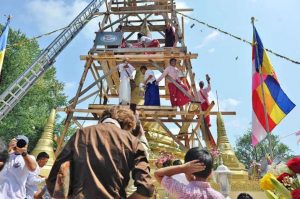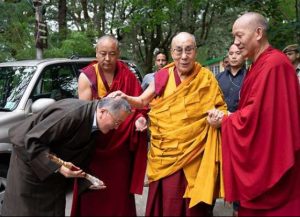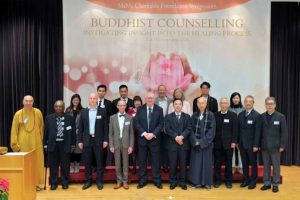
Then the Nāga King Mucalinda, having understood that the sky was now clear without a cloud, having unravelled his coils from the Gracious One’s body, and after withdrawing his own form, and creating the appearance of a young brāhmaṇa, stood in front of the Gracious One, revering the Gracious One with raised hands.
Mucalinda Sutta
The Metropolitan Museum of Art in New York will display more than 140 objects of early Buddhist art in a special exhibition titled “Tree & Serpent: Early Buddhist Art in India, 200 BCE–400 CE” from 18 July to 13 November. From majestic stone reliefs to sacred reliquaries to exquisite jewelry, the exhibition will tell the story of Buddhist art’s beginnings, through a presentation of evocative and interlocking themes about this formative period in early Indian art. Key to this moment were the early narrative traditions that informed figurative sculpture in India, as well as its pre-Buddhist origins.
The Met has secured loans from more than a dozen lenders across Europe, India, and the US to make the exhibition possible. A diverse range of media will be showcased at this exhibition, from precious metals such as gold, silver, and bronze, to ivory, rock crystal, and limestone. As the exhibition website states:
Highlights include spectacular sculptures from southern India—newly discovered and never before publicly exhibited masterpieces—that add to the world canon of early Buddhist art.
(Metropolitan Museum of Art)
The objects’ provenances stretch to the most ancient centuries of Buddhism, or pre-sectarian Buddhism, between 2,200 years ago to the fifth century CE. The times demarcate approximately 300–400 years after the historical Buddha’s passing, during which the first genres of Buddhist art appeared on the Indian subcontinent, and several centuries after the Mahayana Buddhist schools spread across Asia.
The title is particularly powerful and gives a vivid impression of what visitors to the exhibition can expect. Since the beginnings of civilization, the serpent has slithered into human culture and consciousness as an archetype of wisdom and divine insight. The tree is also a cross-cultural symbol of life and enlightenment, with the Bodhi tree being an early object of reverence due to its relationship with the Buddha. As the exhibition will demonstrate, however, the role of trees and snakes in Buddhist art dates to even before the Buddha’s time. When recalling the first period after the Buddha attained enlightenment, stories of old recall that he sat beneath a Mucalinda tree, while Mucalinda himself, the five-headed king of the serpents—who is prominently featured in the “Tree & Serpent” exhibition—sheltered the Blessed One from a storm that raged for seven days and nights. There are few other scenes in the Buddhist scriptures that highlight more strongly the power of the tree and the snake in the story of the Buddha and pre-sectarian Buddhism.
In a June 2022 lecture given at the Chau Chak Wing Museum, Sydney, about the upcoming “Tree & Serpent” exhibition, curator John Guy noted that trees and snakes were seen as the personifications of nature-spirit deities. They became a pervasive presence in the earliest forms of Buddhist art, which manifested materially as stupas. Spatially and artistically, the stupa was critical as it not only housed the relics of the Buddha, “but also honored him through symbolic representations and visual storytelling.” (Metropolitan Museum of Art)

“Tree & Serpent” will display original relics, reliquaries, and the Buddha image as the core exhibits. On many of these early stupas, specifically along the relief panels, whether on stupa drums, enclosure railings, or monumental gateways, appear imagery of trees and snakes. At stupa sites in the Deccan, such as Andhradesa, Kanaganahalli, Phanigiri, and other places along the Krishna River, serpents and trees were “systematically appropriated into the artistic repertoire in the service of early Buddhism.” (GLAM)
An upcoming catalogue by Guy, Tree and Serpent: Early Buddhist Art in India, will be published by the Met in July 2023. Tree and Serpent will consist of contributions from scholars around the world on the subjects of Indo-Roman exchange and Roman bronzes and coins found in India, the broader economic patterns of India in classical antiquity, and the financial lives of monks. As the book is an accompaniment to the exhibition, Tree and Serpent: Early Buddhist Art in India will also address stupas, relics, and pre-Buddhist nature cults. These pre-Buddhist cults worshipped tree spirits, the earth, and water, and their primordial presence is evident in the art.
When the Buddha appeared in the world, these forces of nature would all be incorporated into the new wisdom tradition, as his movement grew from a set of meditative and ethical teachings into a great religious tradition spanning all India, South Asia, and beyond.
The exhibition is made possible by Reliance Industries Limited, The Robert H. N. Ho Family Foundation Global, and the Fred Eychaner Fund.
Major support is provided by the Estate of Brooke Astor, the Florence and Herbert Irving Fund for Asian Art Exhibitions, and the E. Rhodes and Leona B. Carpenter Foundation.
The symposium is made possible by the Fred Eychaner Fund.
The catalogue is made possible by the Florence and Herbert Irving Fund for Asian Art Publications.
Additional support is provided by Albion Art Co., Ltd.
(Metropolitan Museum of Art)
See more
Tree & Serpent: Early Buddhist Art in India, 200 BCE–400 CE (Metropolitan Museum of Art)
Ubiquitous Trees and Serpents: Early Buddhist Imagery of Southern India (GLAM)
Tree and Serpent: Early Buddhist Art in India (Yale University Press)
Mucalindasutta (SuttaCentral)













Actually in India, the archeolosts are not as honest as the Europeans, thats the reason why the ancient Buddhist culture was hijacked and same thing is happening now also. Otherwise wherever there are ancient temples belonging to Hindus, are Buddhist sites.
Totally agree